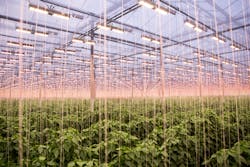You don’t have to be a big Dutch lighting company — i.e., Signify — to win a horticultural lighting job in Holland. Montreal’s Sollum Technologies has won a contract to provide LED toplighting to a 22-acre orchid farm about 80 miles northwest of Signify headquarters.
Maarel Orchids, in Maasdijk near the west coast, is installing the system to supplement natural light, especially in wintertime and on cloudy days. The Sollum package includes controls that allow Maarel to change not only the intensity but also the spectral content of the light to suit the changing needs of the orchids over time, Sollum told LEDs Magazine.
Sollum declined to reveal how much of the 22 acres it is lighting, or to say how much Maarel is paying. Maarel and Sollum are currently planning optimal layout and recipes, along with Dutch horticultural lighting advisors Ledgnd B.V. Actual installation will happen later, when Sollum will replace existing high-pressure sodium lights, a Sollum spokesperson told LEDs.
“Sollum’s dynamic LED lighting solution gives us the ability to control every aspect of our lighting so that it continuously meets the needs of our plants, even as they change,” said Maarel managing director Rene Vissers.
Maarel grows 25 varieties of the Phalaenopsis genus of orchids, with an average of two branches and fourteen flowers. Various horticultural websites note that Phalaenopsis prefers indirect sunlight, something which the Sollum software and planners would consider as they design the Maarel scheme.
Phalaenopsis also likes warmth, which is a factor that Sollum, Maarel, and Ledgnd will have to consider vis-a-vis their replacement of physically warmer HPS lights. As LEDs has reported many times, growers of different flowers, fruits, and vegetables have examined the heat ramifications of colder but more efficient LEDs versus warmer, less efficient HPS in making their lighting decisions.
Sollum refers to its hardware and software combination as “SUN as a Service” (SUNaaS), which it describes as a cloud platform loaded with information on light recipes for different crops, and on the sun’s morning-to-evening spectral patterns anywhere in the world. Growers can adjust settings from phones and tablets. Users pay a service fee for the SUNaaS portion. The SUN as a Service technology has won an LEDs Magazine Sapphire Award for horticultural lighting product innovation.
The deal with Maarel marks the first installation for the seven-year-old company outside of Canada or the U.S.
While Sollum has now encroached on Signify’s backyard, Eindhoven-based Signify has scored its own share of wins in Sollum’s home country. Some of Signify’s Canadian projects include a vertical greens farm in Guelph, Ontario; a cucumber grower in Kingsville, Ontario (Canada’s southernmost town where Sollum is lighting a pepper farm — see photos); an Acme, Alberta tomato and strawberry farm, and a lettuce grower in Aldergrove, British Columbia.
MARK HALPER is a contributing editor for LEDs Magazine, and an energy, technology, and business journalist ([email protected]).
*Updated Mar. 29, 2022 1:44 PM for SUNaaS service fee clarification.
For up-to-the-minute LED and SSL updates, why not follow us on Twitter? You’ll find curated content and commentary, as well as information on industry events, webcasts, and surveys on our LinkedIn Company Page and our Facebook page.

Mark Halper | Contributing Editor, LEDs Magazine, and Business/Energy/Technology Journalist
Mark Halper is a freelance business, technology, and science journalist who covers everything from media moguls to subatomic particles. Halper has written from locations around the world for TIME Magazine, Fortune, Forbes, the New York Times, the Financial Times, the Guardian, CBS, Wired, and many others. A US citizen living in Britain, he cut his journalism teeth cutting and pasting copy for an English-language daily newspaper in Mexico City. Halper has a BA in history from Cornell University.






